fuel filter SSANGYONG KORANDO 2013 User Guide
[x] Cancel search | Manufacturer: SSANGYONG, Model Year: 2013, Model line: KORANDO, Model: SSANGYONG KORANDO 2013Pages: 1336, PDF Size: 92.18 MB
Page 251 of 1336
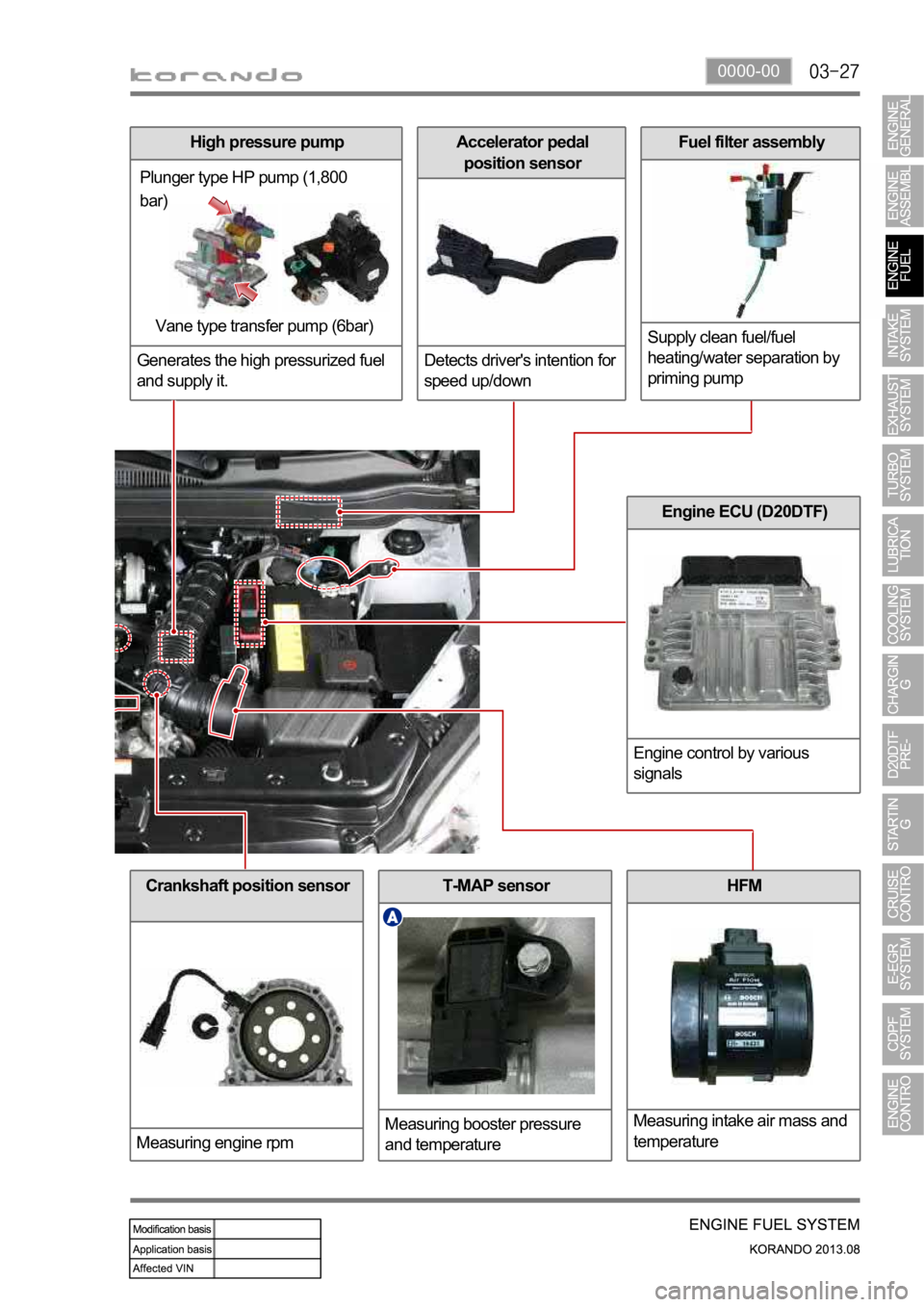
0000-00
Crankshaft position sensor
Measuring engine rpmT-MAP sensor
Measuring booster pressure
and temperatureHFM
Measuring intake air mass and
temperature
Engine ECU (D20DTF)
Engine control by various
signals
High pressure pump
Generates the high pressurized fuel
and supply it.
Plunger type HP pump (1,800
bar)
Vane type transfer pump (6bar)
Accelerator pedal
position sensor
Detects driver's intention for
speed up/downFuel filter assembly
Supply clean fuel/fuel
heating/water separation by
priming pump
Page 252 of 1336
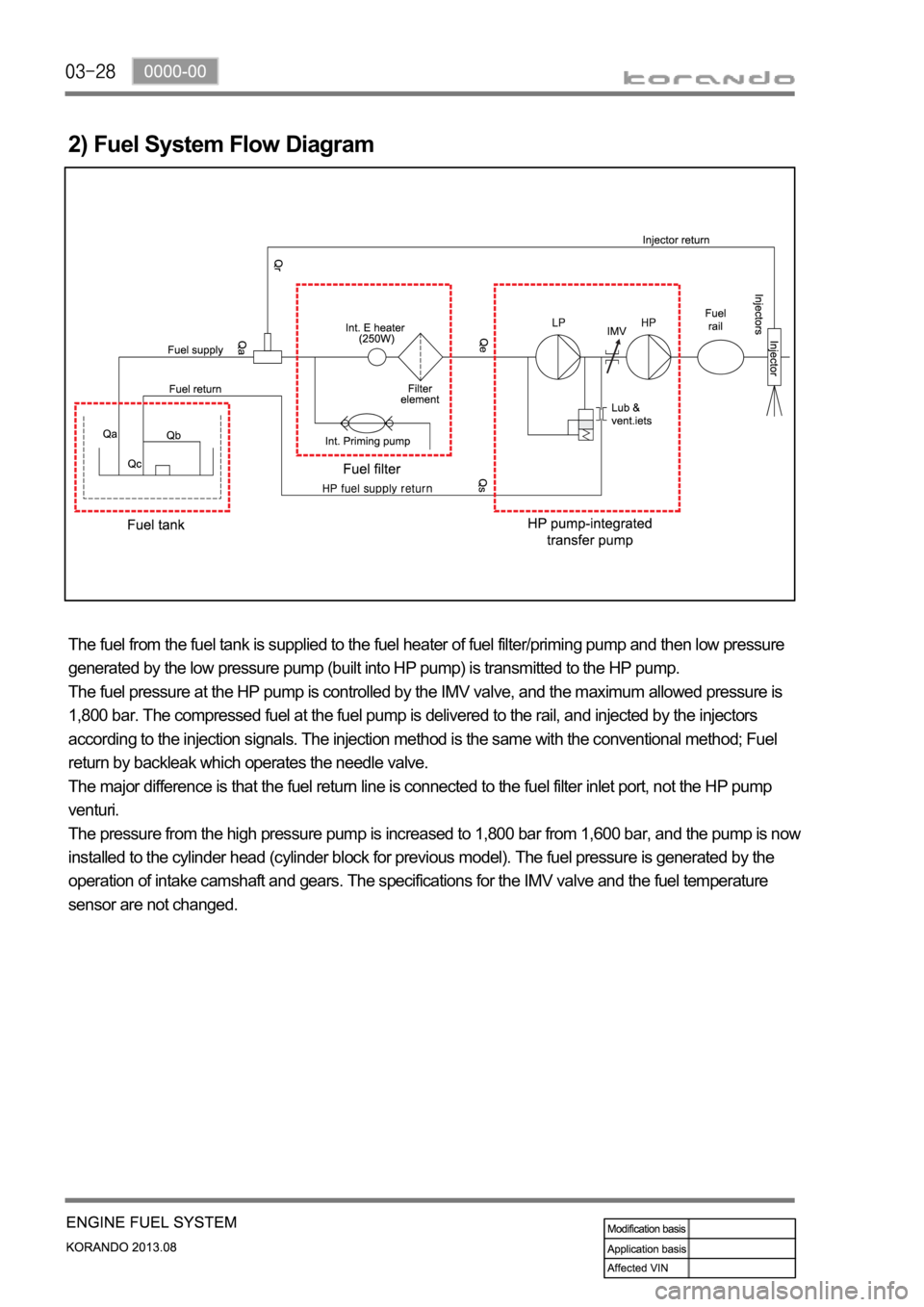
2) Fuel System Flow Diagram
The fuel from the fuel tank is supplied to the fuel heater of fuel filter/priming pump and then low pressure
generated by the low pressure pump (built into HP pump) is transmitted to the HP pump.
The fuel pressure at the HP pump is controlled by the IMV valve, and the maximum allowed pressure is
1,800 bar. The compressed fuel at the fuel pump is delivered to the rail, and injected by the injectors
according to the injection signals. The injection method is the same with the conventional method; Fuel
return by backleak which operates the needle valve.
The major difference is that the fuel return line is connected to the fuel filter inlet port, not the HP pump
venturi.
The pressure from the high pressure pump is increased to 1,800 bar from 1,600 bar, and the pump is now
installed to the cylinder head (cylinder block for previous model). The fuel pressure is generated by the
operation of intake camshaft and gears. The specifications for the IMV valve and the fuel temperature
sensor are not changed.
Page 360 of 1336
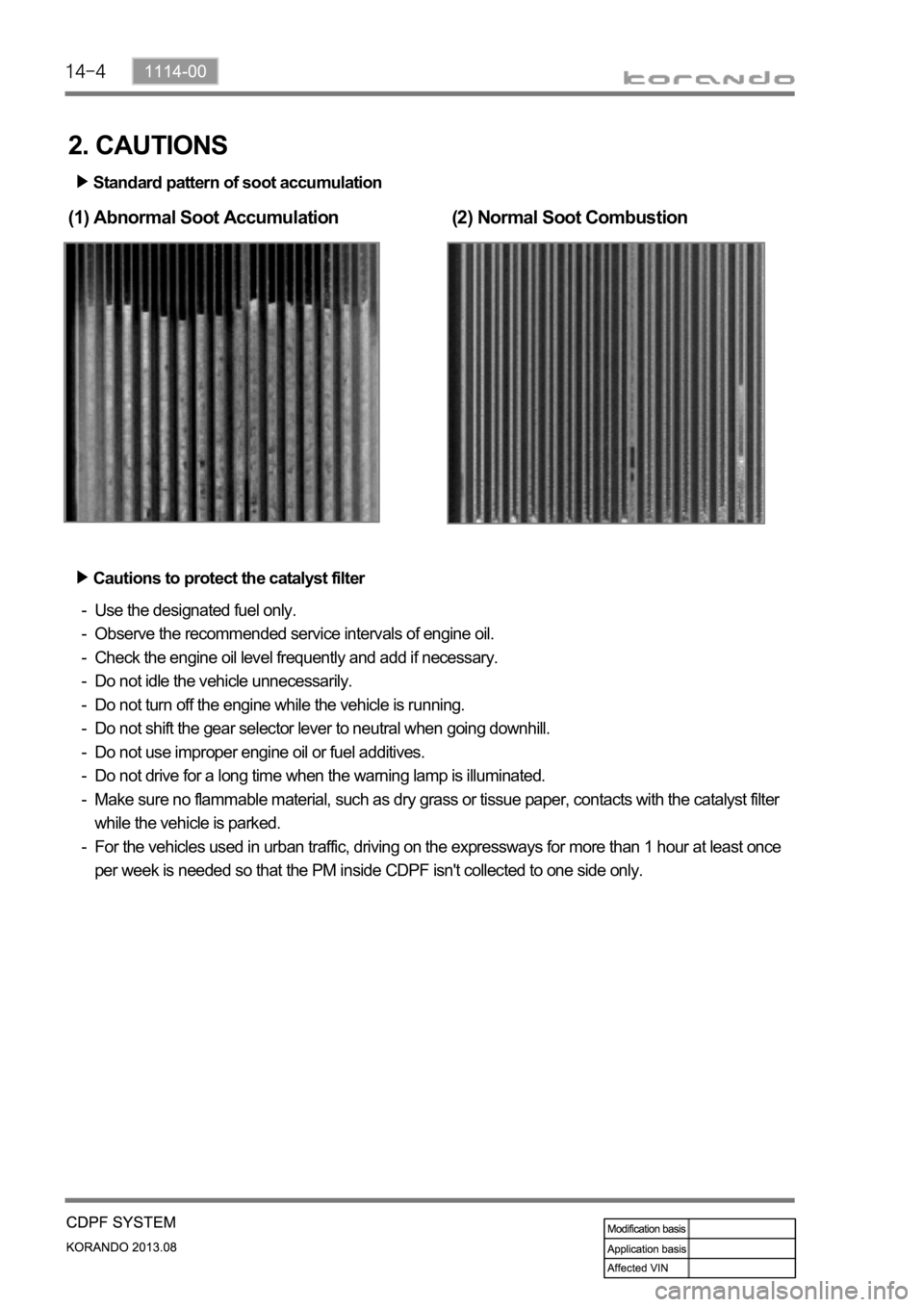
2. CAUTIONS
Standard pattern of soot accumulation
(1) Abnormal Soot Accumulation(2) Normal Soot Combustion
Cautions to protect the catalyst filter
Use the designated fuel only.
Observe the recommended service intervals of engine oil.
Check the engine oil level frequently and add if necessary.
Do not idle the vehicle unnecessarily.
Do not turn off the engine while the vehicle is running.
Do not shift the gear selector lever to neutral when going downhill.
Do not use improper engine oil or fuel additives.
Do not drive for a long time when the warning lamp is illuminated.
Make sure no flammable material, such as dry grass or tissue paper, contacts with the catalyst filter
while the vehicle is parked.
For the vehicles used in urban traffic, driving on the expressways for more than 1 hour at least once
per week is needed so that the PM inside CDPF isn't collected to one side only. -
-
-
-
-
-
-
-
-
-
Page 371 of 1336
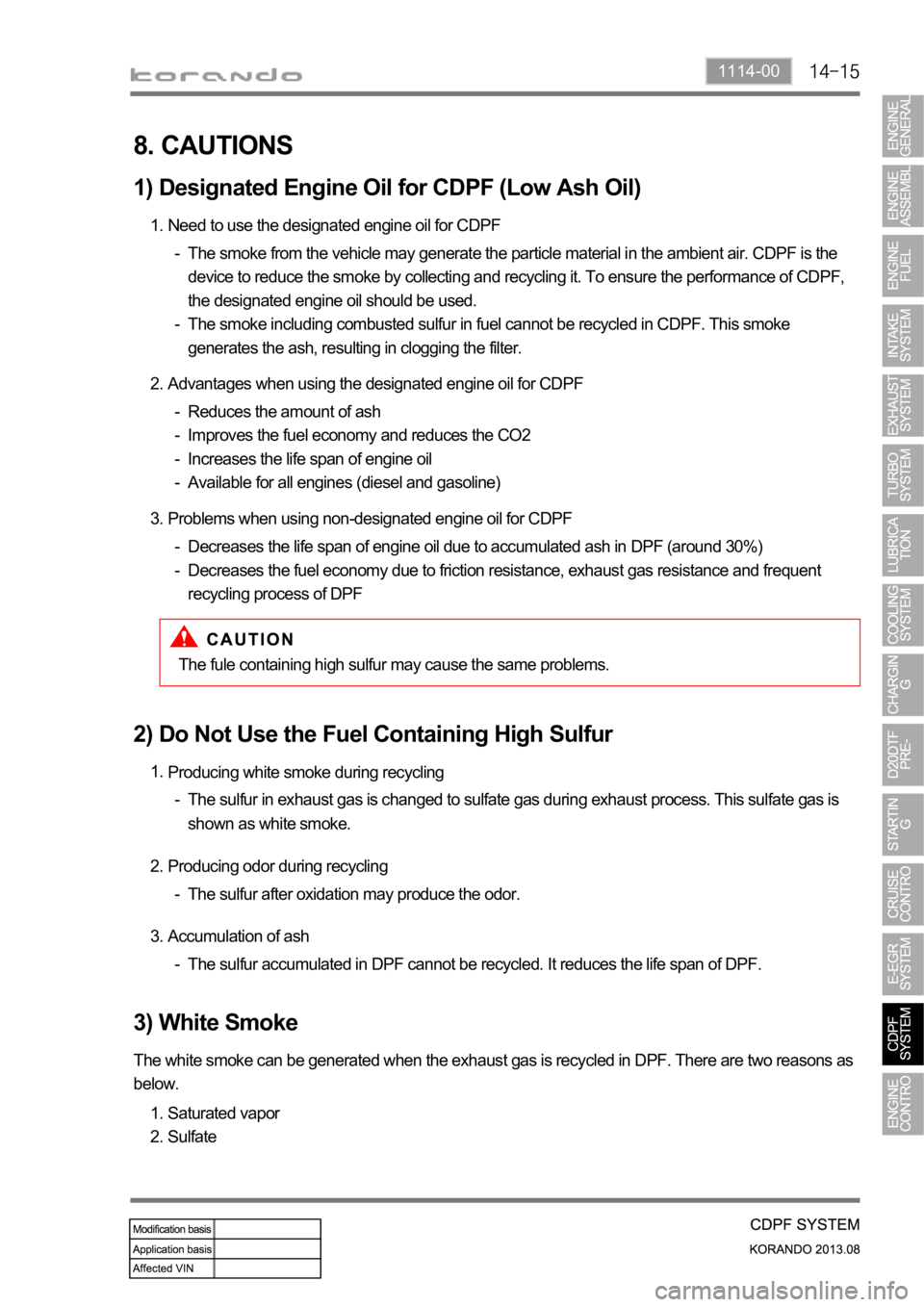
1114-00
8. CAUTIONS
1) Designated Engine Oil for CDPF (Low Ash Oil)
Need to use the designated engine oil for CDPF 1.
The smoke from the vehicle may generate the particle material in the ambient air. CDPF is the
device to reduce the smoke by collecting and recycling it. To ensure the performance of CDPF,
the designated engine oil should be used.
The smoke including combusted sulfur in fuel cannot be recycled in CDPF. This smoke
generates the ash, resulting in clogging the filter. -
-
Advantages when using the designated engine oil for CDPF 2.
Reduces the amount of ash
Improves the fuel economy and reduces the CO2
Increases the life span of engine oil
Available for all engines (diesel and gasoline) -
-
-
-
Problems when using non-designated engine oil for CDPF 3.
Decreases the life span of engine oil due to accumulated ash in DPF (around 30%)
Decreases the fuel economy due to friction resistance, exhaust gas resistance and frequent
recycling process of DPF -
-
The fule containing high sulfur may cause the same problems.
2) Do Not Use the Fuel Containing High Sulfur
Producing white smoke during recycling 1.
The sulfur in exhaust gas is changed to sulfate gas during exhaust process. This sulfate gas is
shown as white smoke. -
Producing odor during recycling 2.
The sulfur after oxidation may produce the odor. -
Accumulation of ash 3.
The sulfur accumulated in DPF cannot be recycled. It reduces the life span of DPF. -
3) White Smoke
The white smoke can be generated when the exhaust gas is recycled in DPF. There are two reasons as
below.
Saturated vapor
Sulfate 1.
2.
Page 384 of 1336
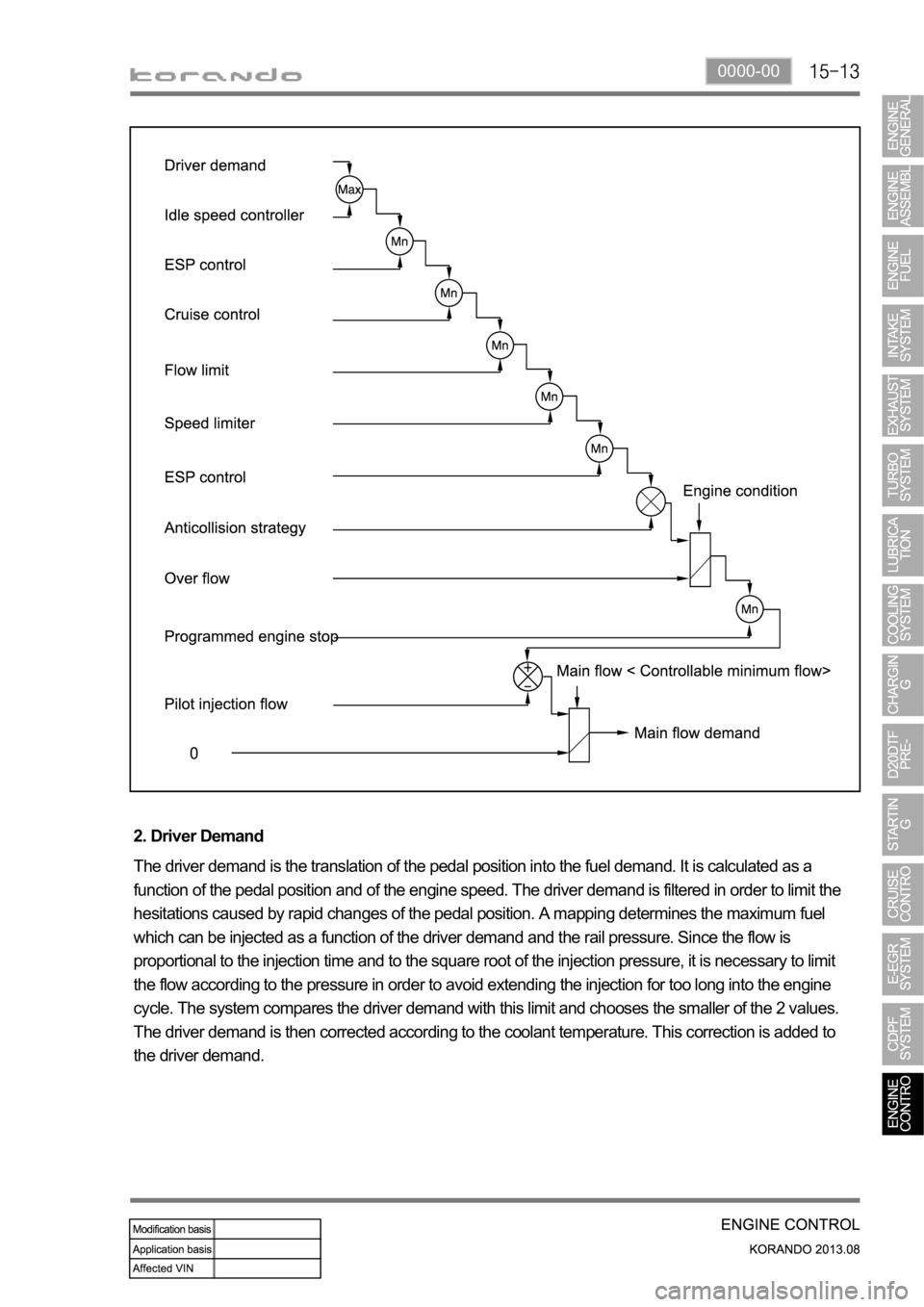
0000-00
2. Driver Demand
The driver demand is the translation of the pedal position into the fuel demand. It is calculated as a
function of the pedal position and of the engine speed. The driver demand is filtered in order to limit the
hesitations caused by rapid changes of the pedal position. A mapping determines the maximum fuel
which can be injected as a function of the driver demand and the rail pressure. Since the flow is
proportional to the injection time and to the square root of the injection pressure, it is necessary to limit
the flow according to the pressure in order to avoid extending the injection for too long into the engine
cycle. The system compares the driver demand with this limit and chooses the smaller of the 2 values.
The driver demand is then corrected according to the coolant temperature. This correction is added to
the driver demand.
Page 418 of 1336
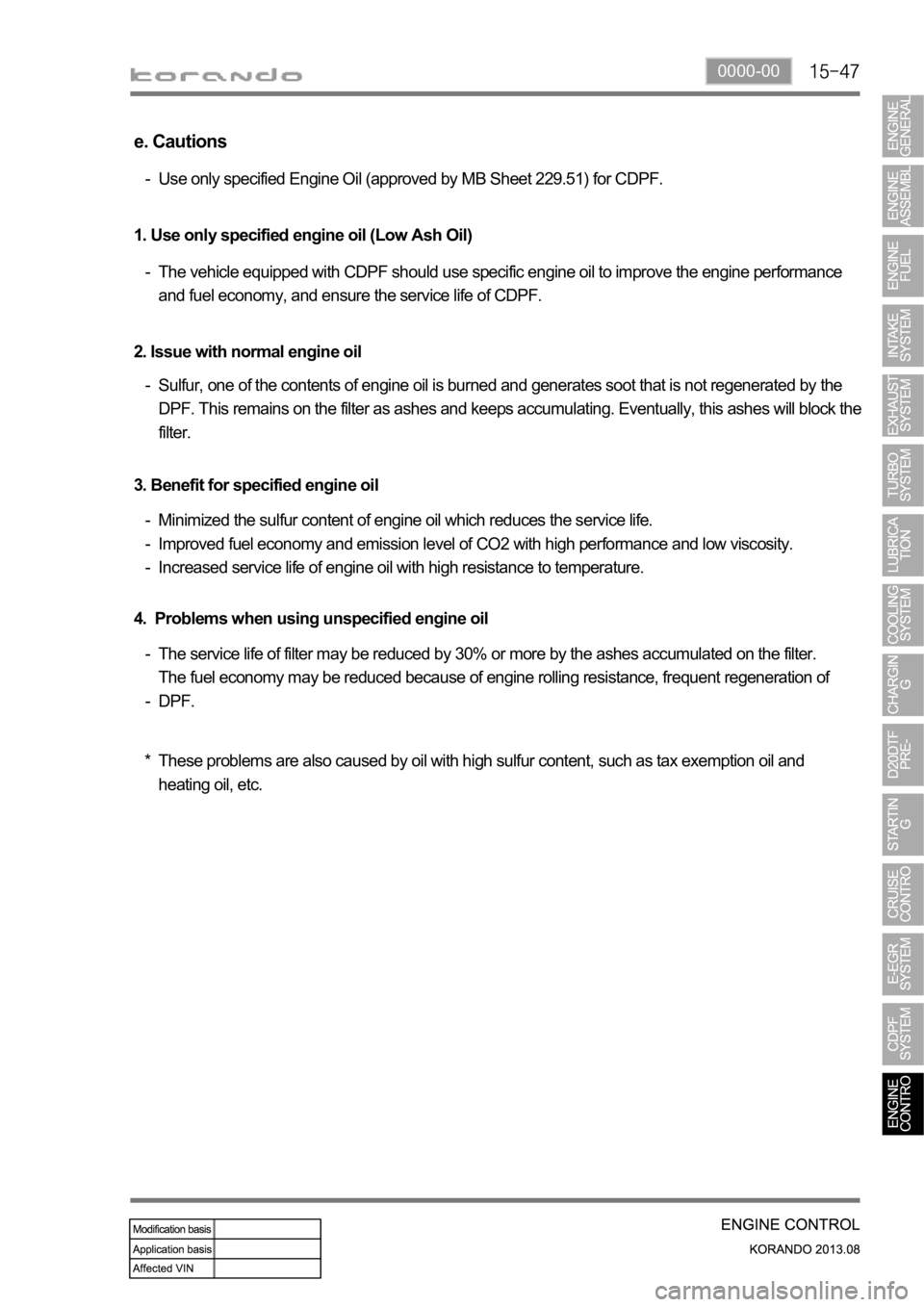
0000-00
e. Cautions
Use only specified Engine Oil (approved by MB Sheet 229.51) for CDPF. -
1. Use only specified engine oil (Low Ash Oil)
The vehicle equipped with CDPF should use specific engine oil to improve the engine performance
and fuel economy, and ensure the service life of CDPF. -
2. Issue with normal engine oil
Sulfur, one of the contents of engine oil is burned and generates soot that is not regenerated by the
DPF. This remains on the filter as ashes and keeps accumulating. Eventually, this ashes will block the
filter. -
3. Benefit for specified engine oil
Minimized the sulfur content of engine oil which reduces the service life.
Improved fuel economy and emission level of CO2 with high performance and low viscosity.
Increased service life of engine oil with high resistance to temperature. -
-
-
4. Problems when using unspecified engine oil
The service life of filter may be reduced by 30% or more by the ashes accumulated on the filter.
The fuel economy may be reduced because of engine rolling resistance, frequent regeneration of
DPF. -
-
These problems are also caused by oil with high sulfur content, such as tax exemption oil and
heating oil, etc. *
Page 424 of 1336
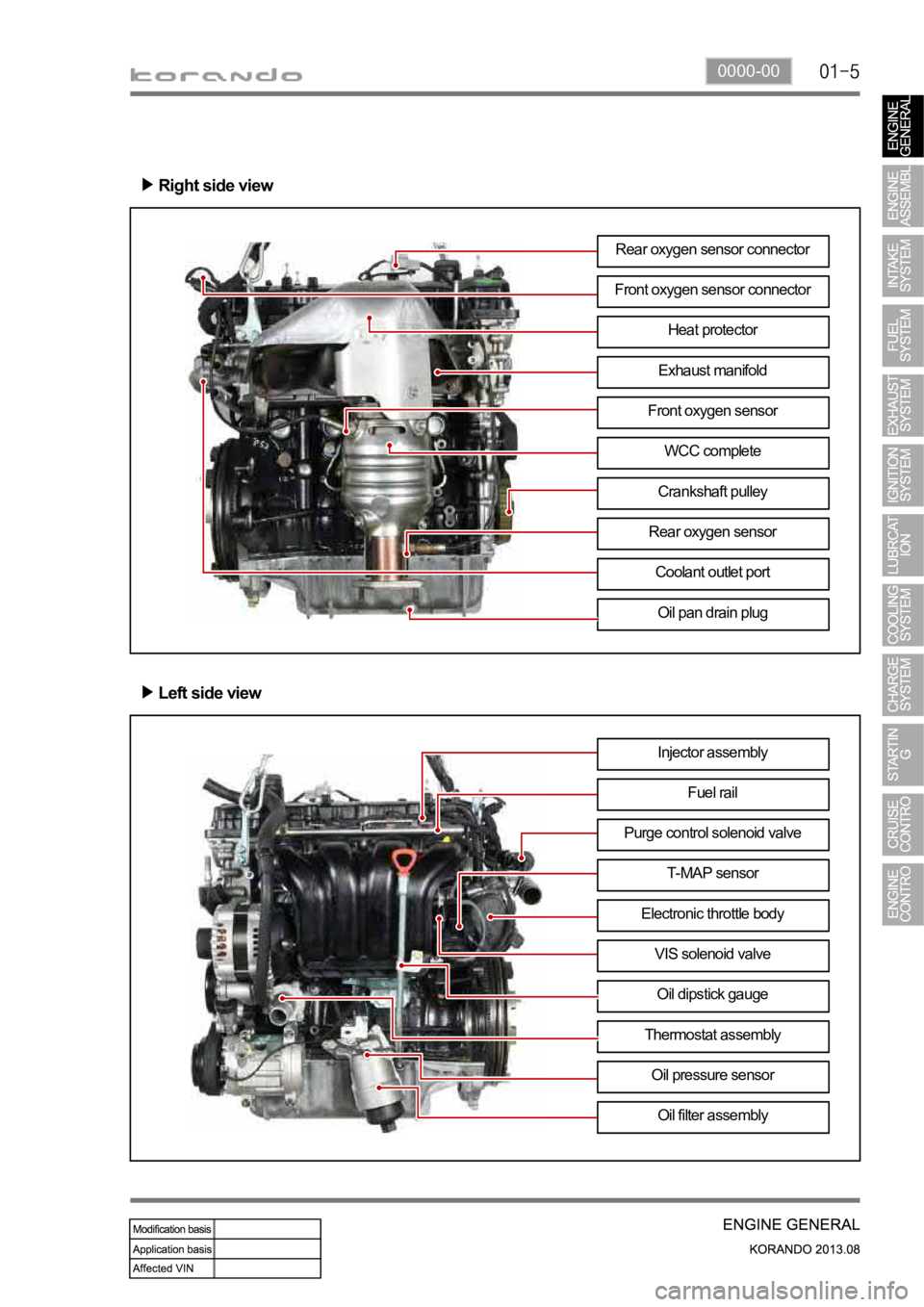
0000-00
Right side view
Left side view
Rear oxygen sensor connector
Front oxygen sensor connector
Exhaust manifoldHeat protector
Front oxygen sensor
WCC complete
Crankshaft pulley
Oil pan drain plug
Rear oxygen sensor
Coolant outlet port
Injector assembly
Fuel rail
T-MAP sensor Purge control solenoid valve
Electronic throttle body
VIS solenoid valve
Oil dipstick gauge
Oil filter assembly
Thermostat assembly
Oil pressure sensor
Page 441 of 1336
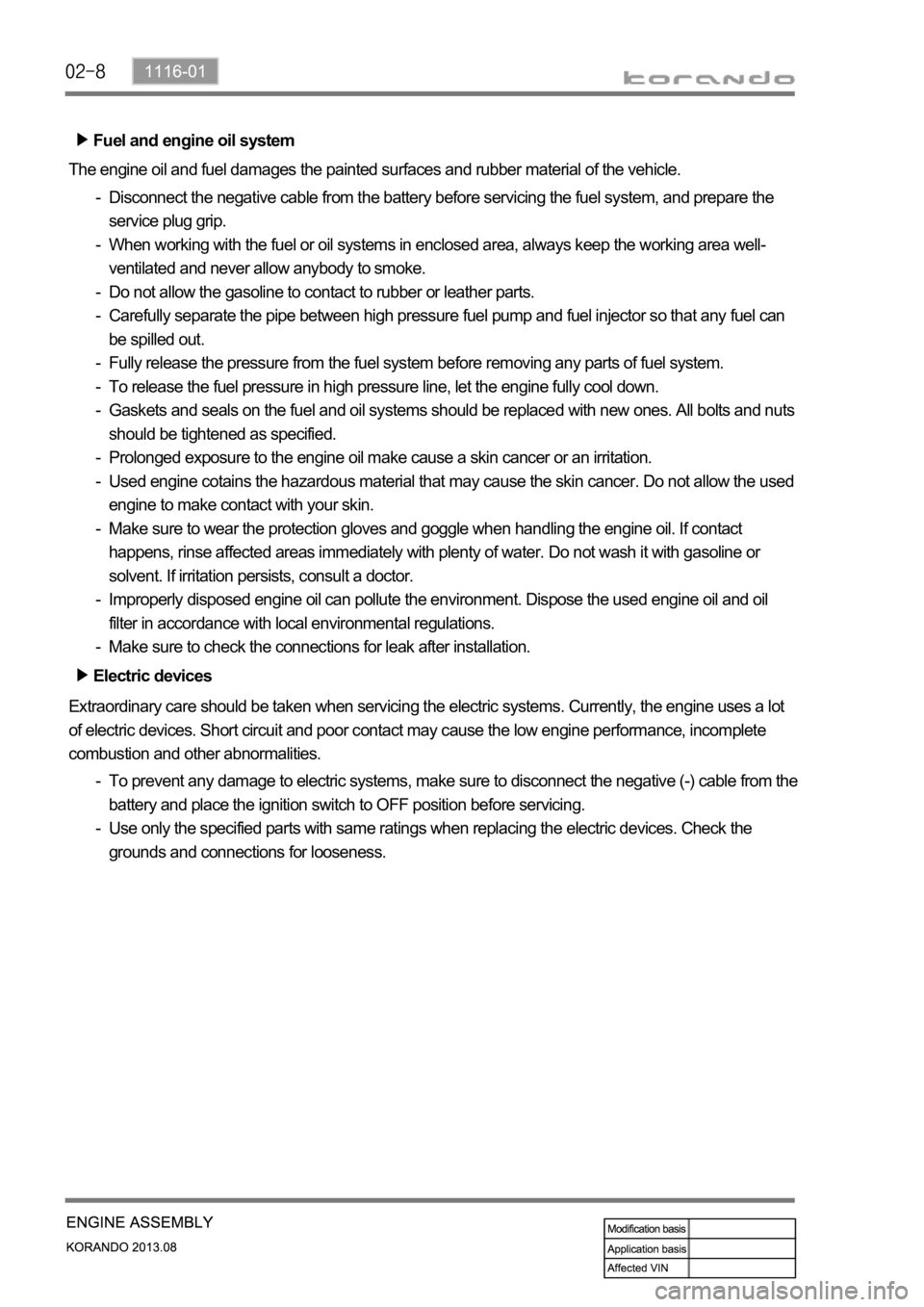
Fuel and engine oil system
The engine oil and fuel damages the painted surfaces and rubber material of the vehicle.
Disconnect the negative cable from the battery before servicing the fuel system, and prepare the
service plug grip.
When working with the fuel or oil systems in enclosed area, always keep the working area well-
ventilated and never allow anybody to smoke.
Do not allow the gasoline to contact to rubber or leather parts.
Carefully separate the pipe between high pressure fuel pump and fuel injector so that any fuel can
be spilled out.
Fully release the pressure from the fuel system before removing any parts of fuel system.
To release the fuel pressure in high pressure line, let the engine fully cool down.
Gaskets and seals on the fuel and oil systems should be replaced with new ones. All bolts and nuts
should be tightened as specified.
Prolonged exposure to the engine oil make cause a skin cancer or an irritation.
Used engine cotains the hazardous material that may cause the skin cancer. Do not allow the used
engine to make contact with your skin.
Make sure to wear the protection gloves and goggle when handling the engine oil. If contact
happens, rinse affected areas immediately with plenty of water. Do not wash it with gasoline or
solvent. If irritation persists, consult a doctor.
Improperly disposed engine oil can pollute the environment. Dispose the used engine oil and oil
filter in accordance with local environmental regulations.
Make sure to check the connections for leak after installation. -
-
-
-
-
-
-
-
-
-
-
-
Electric devices
To prevent any damage to electric systems, make sure to disconnect the negative (-) cable from the
battery and place the ignition switch to OFF position before servicing.
Use only the specified parts with same ratings when replacing the electric devices. Check the
grounds and connections for looseness. -
- Extraordinary care should be taken when servicing the electric systems. Currently, the engine uses a lot
of electric devices. Short circuit and poor contact may cause the low engine performance, incomplete
combustion and other abnormalities.
Page 480 of 1336
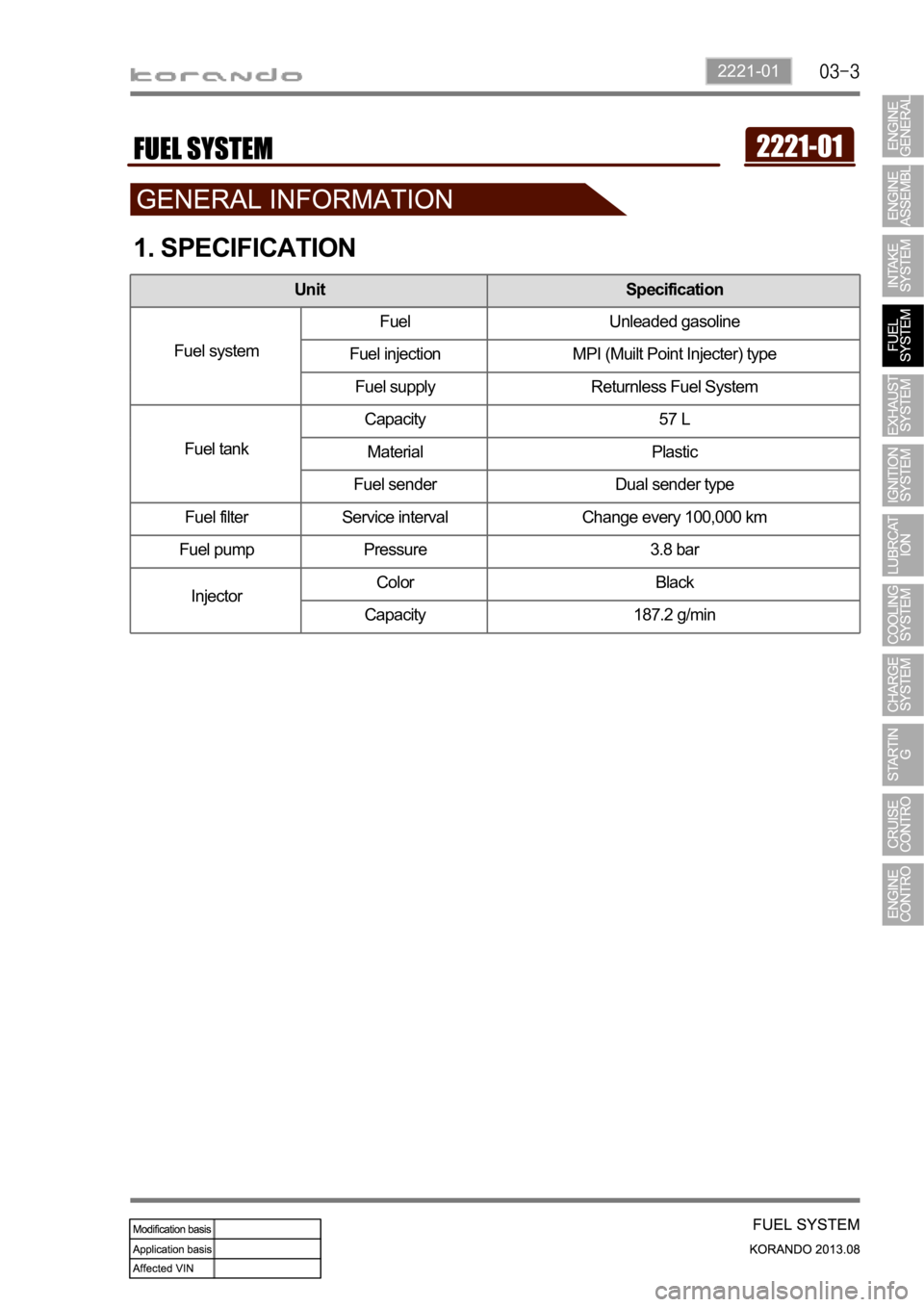
2221-01
1. SPECIFICATION
Unit Specification
Fuel systemFuel Unleaded gasoline
Fuel injection MPI (Muilt Point Injecter) type
Fuel supply Returnless Fuel System
Fuel tankCapacity 57 L
Material Plastic
Fuel sender Dual sender type
Fuel filter Service interval Change every 100,000 km
Fuel pump Pressure 3.8 bar
InjectorColor Black
Capacity 187.2 g/min
Page 482 of 1336

2221-01
Fuel Filter Assy
Bolt
Fuel Return Pipe
Fuel Supply pipe
Fuel Vapor Pipe Assy
Canister Compl
Fuel line Holder
Fuel line Holder 1.
2.
3.
4.
6.
9.
14.
15.